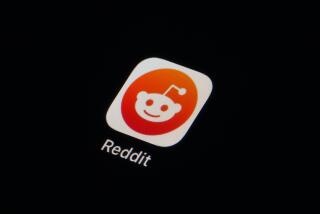Connections are his currency
- Share via
MOUNTAIN VIEW, CALIF — . -- Few Internet entrepreneurs practice what they preach as devoutly as LinkedIn Corp. co-founder Reid Hoffman, whose business revolves around his belief that good fortune flows from good relationships.
Hoffman, 40, has put that principle to work by mining his own vast network of Silicon Valley connections to rake in one Internet jackpot after another.
A college friendship led Hoffman to PayPal and his first windfall when EBay Inc. bought the online payment service for $1.5 billion in 2002. Since then, he has become even wealthier by investing in other Internet start-ups he discovered through friends and former colleagues.
Along the way, Hoffman used some of his PayPal proceeds to help start LinkedIn, an online business-networking service that helps professionals like him realize the value of their contacts.
With more than 1 million people joining each month and projected revenue of $75 million to $100 million this year, LinkedIn Corp. seems likely to deliver another big payoff for Hoffman.
“LinkedIn is a great expression of who Reid is,” said John Lilly, chief executive of Mozilla Corp., maker of the Firefox Web browser, where Hoffman sits on the board of directors. “It’s really his brain on the Web.”
LinkedIn tries to help people who know each other more easily meet others who might help their careers. For example, if Mary and Bob are both part of Fred’s online network, Mary could ask Fred for a referral to Bob, who could then decide whether he wanted to embrace a new relationship with Mary.
LinkedIn’s focus on professional networking distinguishes it from social playgrounds like Facebook and News Corp.’s MySpace, where users are encouraged to share their personal lives by posting party photos and adding favorite bands.
Although it may not sound as much fun, LinkedIn appears to be thriving. About 18 million people now have profiles on the site, roughly twice as many as a year ago.
Hoffman, who remains LinkedIn’s chairman and largest shareholder five years after starting it, said the Mountain View, Calif.,-based company will probably file for an initial public stock offering before 2010 if he isn’t first tempted to sell to one of the suitors that have inquired about buying LinkedIn. Hoffman wouldn’t identify them.
“I know we are going to be much more valuable in a year or two,” Hoffman said. “We have had [buyout] conversations with all the usual suspects, but I think an IPO is by far and away the most likely outcome.”
Nonetheless, LinkedIn has its share of detractors, who see it as little more than a tool for job hunters and employment recruiters, a slightly different twist on online help-wanted services like Monster.com or Yahoo Inc.’s HotJobs. Besides selling ads, the site lets employment recruiters and others pay for expanded access to LinkedIn members.
Although former LinkedIn executive Keith Rabois isn’t as harsh, he believes Hoffman needs to pursue an IPO as soon as possible to create a bigger buzz about the service.
“Right now, LinkedIn just doesn’t seem to be at the center of the Internet universe, and an IPO would be an amazing marketing opportunity,” said Rabois, who left LinkedIn last year to join another rapidly growing start-up, Slide Inc.
LinkedIn hasn’t generated the same kind of buzz as Facebook Inc., which has been attracting many of the same users as LinkedIn. With 60 million users, privately held Facebook has already been valued at $15 billion by its recent investors and indicated it would pursue its own IPO in 2009 or 2010.
Hoffman happens to have a stake in Facebook, underscoring his knack for identifying promising Internet opportunities in their early stages.
“It’s like he is able to look at the Internet and figure out where all the pieces fit together,” said Mark Kvamme, a partner at Sequoia Capital and a member of LinkedIn’s board.
Although Facebook could produce Hoffman’s biggest investment return, it threatens to become a thorn in his side if it diminishes the amount of time people spend at LinkedIn.
As a countermeasure, LinkedIn in recent months has been adopting more Facebook-like features. The changes have allowed LinkedIn users to display pictures next to their personal profiles and opened up the site for outsiders to post mini-applications, known as widgets, designed to help people with common connections share information.
Despite those copycat moves, Hoffman insists he isn’t worried about Facebook, which he views as being far too casual and goofy for the ambitious professionals drawn to LinkedIn.
Hoffman credits his own connections for his successful investment streak.
“Any time there were some really good people involved with a potentially good product, I thought I should probably throw in at least a little bit of money if I had the option,” he said.
That doesn’t mean he invests in every venture started by people he knows, sometimes to his regret.
For instance, Hoffman hadn’t felt compelled to invest in YouTube when he had the chance, depriving him of a huge payday when Google Inc. bought the popular video-sharing site for $1.65 billion in 2006. Instead, LinkedIn provided some initial office space to YouTube founders Chad Hurley and Steve Chen, who worked with Hoffman at PayPal.
Hoffman hasn’t been wrong too often.
Three of his start-up investments have been sold since 2005 for more than $1.1 billion combined, although Hoffman got only a sliver of that. They are the photo-sharing site Flickr, bought by Yahoo Inc.; music network Last.fm, bought by CBS Corp.; and computer security specialist IronPort Systems Inc., bought by Cisco Systems Inc.
Besides Facebook, the list of promising prospects in Hoffman’s portfolio includes blogging software maker Six Apart, blogging search engine Technorati Inc., online content-ranking site Digg Inc. and another online social networking service, Ning Inc. He also holds stakes in a variety of lesser-known start-ups too.
Hoffman’s connections and investments frequently have ties to PayPal, where he accumulated stock as a director and then as a top executive. He first met PayPal’s co-founder and chief executive, Peter Thiel, while both were at Stanford University in the 1980s.
Thiel, an early LinkedIn investor who is now a venture capitalist and Facebook director, is one of the more than 1,500 connections that Hoffman lists on LinkedIn’s site.
“I pay a lot of attention to building relationships,” he said.
“Part of how to create a lot of value and goodwill in the system is by doing something that is a little bit of work for me and massively valuable for you.”
Thiel marvels at how well the philosophy seems to work for Hoffman.
“Everybody in Silicon Valley is no more than two degrees away from being connected to Reid.”






